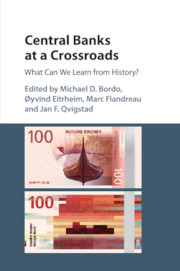51 results
Sovereign Collateral
-
- Journal:
- The Journal of Economic History / Volume 84 / Issue 1 / March 2024
- Published online by Cambridge University Press:
- 21 February 2024, pp. 191-231
- Print publication:
- March 2024
-
- Article
-
- You have access
- Open access
- HTML
- Export citation
6 - The Other Way: A Narrative History of the Bank of France
-
-
- Book:
- Sveriges Riksbank and the History of Central Banking
- Published online:
- 10 May 2018
- Print publication:
- 24 May 2018, pp 206-241
-
- Chapter
- Export citation
6 - Reputation, Regulation, and the Collapse of International Capital Markets, 1920–1935
-
-
- Book:
- Financial Systems and Economic Growth
- Published online:
- 06 October 2017
- Print publication:
- 01 September 2017, pp 157-200
-
- Chapter
- Export citation
“High & Dry”: The Liquidity and Credit of Colonial and Foreign Government Debt and the London Stock Exchange (1880–1910)
-
- Journal:
- The Journal of Economic History / Volume 77 / Issue 3 / September 2017
- Published online by Cambridge University Press:
- 21 August 2017, pp. 653-691
- Print publication:
- September 2017
-
- Article
-
- You have access
- HTML
- Export citation
Editors and contributors
-
- Book:
- Central Banks at a Crossroads
- Published online:
- 05 June 2016
- Print publication:
- 09 June 2016, pp ix-xv
-
- Chapter
- Export citation
Contents
-
- Book:
- Central Banks at a Crossroads
- Published online:
- 05 June 2016
- Print publication:
- 09 June 2016, pp vii-viii
-
- Chapter
- Export citation
Preface
-
- Book:
- Central Banks at a Crossroads
- Published online:
- 05 June 2016
- Print publication:
- 09 June 2016, pp xvi-xx
-
- Chapter
- Export citation
Appendices
- from 5 - Central Bank Independence in Small Open Economies
-
- Book:
- Central Banks at a Crossroads
- Published online:
- 05 June 2016
- Print publication:
- 09 June 2016, pp 222-222
-
- Chapter
- Export citation
Appendices
- from 5 - Central Bank Independence in Small Open Economies
-
- Book:
- Central Banks at a Crossroads
- Published online:
- 05 June 2016
- Print publication:
- 09 June 2016, pp 223-230
-
- Chapter
- Export citation
Appendices
- from 5 - Central Bank Independence in Small Open Economies
-
- Book:
- Central Banks at a Crossroads
- Published online:
- 05 June 2016
- Print publication:
- 09 June 2016, pp 221-221
-
- Chapter
- Export citation
Index
-
- Book:
- Central Banks at a Crossroads
- Published online:
- 05 June 2016
- Print publication:
- 09 June 2016, pp 673-696
-
- Chapter
- Export citation
7 - A Century and a Half of Central Banks, International Reserves, and International Currencies
-
-
- Book:
- Central Banks at a Crossroads
- Published online:
- 05 June 2016
- Print publication:
- 09 June 2016, pp 280-318
-
- Chapter
- Export citation
1 - Introduction
-
-
- Book:
- Central Banks at a Crossroads
- Published online:
- 05 June 2016
- Print publication:
- 09 June 2016, pp 1-17
-
- Chapter
- Export citation
Copyright page
-
- Book:
- Central Banks at a Crossroads
- Published online:
- 05 June 2016
- Print publication:
- 09 June 2016, pp vi-vi
-
- Chapter
- Export citation

Central Banks at a Crossroads
- What Can We Learn from History?
-
- Published online:
- 05 June 2016
- Print publication:
- 09 June 2016
Media Manipulation in Interwar France: Evidence from the Archive of Banque de Paris et des Pays-Bas, 1914–1937
-
- Journal:
- Contemporary European History / Volume 25 / Issue 1 / February 2016
- Published online by Cambridge University Press:
- 13 January 2016, pp. 11-36
- Print publication:
- February 2016
-
- Article
- Export citation
The Price of Media Capture and the Debasement of the French Newspaper Industry During the Interwar
-
- Journal:
- The Journal of Economic History / Volume 74 / Issue 3 / September 2014
- Published online by Cambridge University Press:
- 29 August 2014, pp. 799-830
- Print publication:
- September 2014
-
- Article
- Export citation
The Untold History of Transparency: Mercantile Agencies, the Law, and the Lawyers (1851–1916)
-
- Journal:
- Enterprise & Society / Volume 15 / Issue 2 / June 2014
- Published online by Cambridge University Press:
- 09 May 2014, pp. 213-251
- Print publication:
- June 2014
-
- Article
- Export citation
Understanding rating addiction: US courts and the origins of rating agencies' regulatory license (1900–1940)
-
- Journal:
- Financial History Review / Volume 20 / Issue 3 / December 2013
- Published online by Cambridge University Press:
- 26 November 2013, pp. 237-257
-
- Article
- Export citation
The Making of Western Indology: Henry Thomas Colebrooke and the East India Company. By Rosane Rocher and Ludo Rocher. London: Routledge, 2012. Pp. xv + 238. ISBN 10: 0415336015; ISBN 13: 9780415336017.
-
- Journal:
- International Journal of Asian Studies / Volume 10 / Issue 2 / July 2013
- Published online by Cambridge University Press:
- 20 June 2013, pp. 207-208
-
- Article
- Export citation

